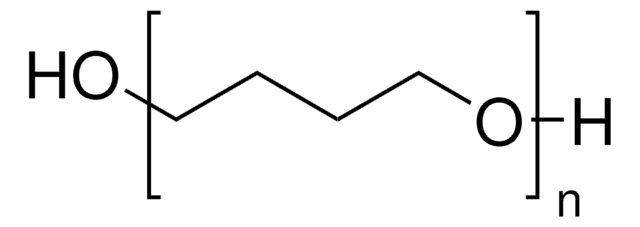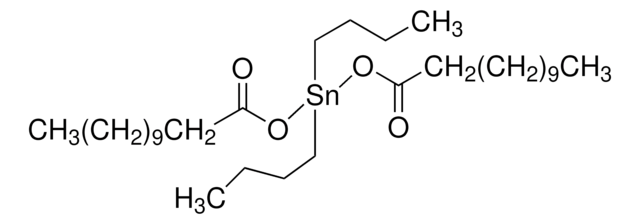345296
Poly(tetrahydrofuran)
average Mn ~1,000
Synonyme(s) :
α-Hydro-ω-hydroxypoly(oxy-1,4-butanediyl), Poly(1,4-butanediol), polyTHF
About This Item
Produits recommandés
Pression de vapeur
<0.01 mmHg ( 25 °C)
<1 mmHg ( 20 °C)
Niveau de qualité
Poids mol.
average Mn ~1,000
Contient
0.05-0.07% BHT as stabilizer
Pf
25-33 °C
Densité
0.974 g/mL at 25 °C
Chaîne SMILES
OCCCCO
InChI
1S/C8H18O2/c1-3-5-6-10-8(4-2)7-9/h8-9H,3-7H2,1-2H3/t8-/m0/s1
Clé InChI
BJZYYSAMLOBSDY-QMMMGPOBSA-N
Vous recherchez des produits similaires ? Visite Guide de comparaison des produits
Catégories apparentées
Application
- Thermally reversible urethane -epoxy networks.
- Poly(hexamethylene 2,6-naphthalate)-block-poly(tetrahydrofuran) (PHN-b-N-pTHF) copolymers with shape memory effect via melt polycondensation.
- Poly(3,4-ethylenedioxythiophene):poly(tetrahydrofuran) composite for the fabrication of memory organic electrochemical transistors.
Caractéristiques et avantages
- High flexibility
- Hydrolytic stability
- Excellent abrasion resistance
Code de la classe de stockage
11 - Combustible Solids
Classe de danger pour l'eau (WGK)
WGK 3
Point d'éclair (°F)
>325.4 °F - Tag open cup
Point d'éclair (°C)
> 163 °C - Tag open cup
Équipement de protection individuelle
dust mask type N95 (US), Eyeshields, Gloves
Faites votre choix parmi les versions les plus récentes :
Déjà en possession de ce produit ?
Retrouvez la documentation relative aux produits que vous avez récemment achetés dans la Bibliothèque de documents.
Notre équipe de scientifiques dispose d'une expérience dans tous les secteurs de la recherche, notamment en sciences de la vie, science des matériaux, synthèse chimique, chromatographie, analyse et dans de nombreux autres domaines..
Contacter notre Service technique







